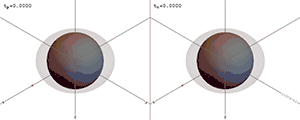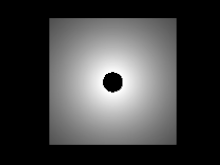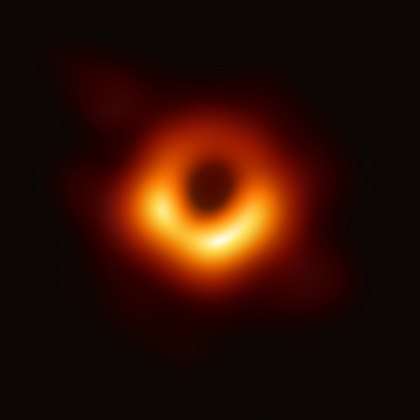Rotating black hole
A rotating black hole is a black hole that possesses angular momentum. In particular, it rotates about one of its axes of symmetry.
.gif)
Types of black holes
There are four known, exact, black hole solutions to the Einstein field equations, which describe gravity in general relativity. Two of those rotate: the Kerr and Kerr–Newman black holes. It is generally believed that every black hole decays rapidly to a stable black hole; and, by the no-hair theorem, that (except for quantum fluctuations) stable black holes can be completely described at any moment in time by these eleven numbers:
- mass-energy M,
- linear momentum P (three components),
- angular momentum J (three components),
- position X (three components),
- electric charge Q.

.gif)
These numbers represent the conserved attributes of an object which can be determined from a distance by examining its electromagnetic and gravitational fields. All other variations in the black hole will either escape to infinity or be swallowed up by the black hole. This is because anything happening inside the black hole horizon cannot affect events outside of it.
In terms of these properties, the four types of black holes can be defined as follows:
| Non-rotating (J = 0) | Rotating (J > 0) | |
|---|---|---|
| Uncharged (Q = 0) | Schwarzschild | Kerr |
| Charged (Q ≠ 0) | Reissner–Nordström | Kerr–Newman |
Note that astrophysical black holes are expected to have non-zero angular momentum, due to their formation via collapse of rotating stellar objects, but effectively zero charge, since any net charge will quickly attract the opposite charge and neutralize. For this reason the term "astrophysical" black hole is usually reserved for the Kerr black hole.[2]
Formation
Rotating black holes are formed in the gravitational collapse of a massive spinning star or from the collapse or collision of a collection of compact objects, stars, or gas with a total non-zero angular momentum. As all known stars rotate and realistic collisions have non-zero angular momentum, it is expected that all black holes in nature are rotating black holes. Since observed astronomical objects do not possess an appreciable net electric charge, only the Kerr solution has astrophysical relevance.
In late 2006, astronomers reported estimates of the spin rates of black holes in The Astrophysical Journal. A black hole in the Milky Way, GRS 1915+105, may rotate 1,150 times per second,[3] approaching the theoretical upper limit.
Relation with gamma ray bursts
The formation of a rotating black hole by a collapsar is thought to be observed as the emission of gamma ray bursts.
Conversion to a Schwarzschild black hole
A rotating black hole can produce large amounts of energy at the expense of its rotational energy. This happens through the Penrose process in the black hole's ergosphere, an area just outside its event horizon. In that case a rotating black hole gradually reduces to a Schwarzschild black hole, the minimum configuration from which no further energy can be extracted, although the Kerr black hole's rotation velocity will never quite reach zero.
Kerr metric, Kerr–Newman metric

A rotating black hole is a solution of Einstein's field equation. There are two known exact solutions, the Kerr metric and the Kerr–Newman metric, which are believed to be representative of all rotating black hole solutions, in the exterior region.
State transition
Rotating black holes have two temperature states they can exist in: heating (losing energy) and cooling. In 1989, Paul Davies argued that the transition between the two states occurs when the square of the black hole's mass-to-angular-momentum ratio, in Planck units, equals the golden ratio.[4] This claim was later found to be incorrect and in contradiction with Davies' earlier work.[5]
In popular culture
Kerr black holes are featured extensively in the 2009 visual novel Steins;Gate (also TV / manga) , for their possibilities in time travelling.[6] These are, however, magnified greatly for the purpose of story telling. Kerr black holes are also key to the "Swan Song" project by Joe Davis (artist).[7][8]
See also
- Black hole spin parameter
- Kerr black holes as wormholes
- BKL singularity – solution representing interior geometry of black holes formed by gravitational collapse.
- Penrose process
- Ergosphere
- Black hole Spin-flip
- Black hole bomb
- Stellar black holes
References
- Visser, Matt (15 January 2008). "The Kerr spacetime: A brief introduction". arXiv:0706.0622 [gr-qc].
- A bot will complete this citation soon. Click here to jump the queue arXiv:1807.06014.
- Hayes, Jacqui (24 November 2006). "Black hole spins at the limit". Cosmos magazine. Archived from the original on 7 May 2012.
- Davies, Paul C. W. (1989). "Thermodynamic phase transitions of Kerr-Newman black holes in de Sitter space". Classical and Quantum Gravity. 6: 1909–1914. Bibcode:1989CQGra...6.1909D. doi:10.1088/0264-9381/6/12/018.
- Baez, John C. (28 February 2013). "Black Holes and the Golden Ratio". Azimuth. Retrieved 26 July 2019.
- "想定科学『Steins;Gate(シュタインズゲート)』公式Webサイト". steinsgate.jp (in Japanese). Retrieved 29 April 2020.
- Mark Hay (23 July 2020). "Meet the man trying to send a warning about history's worst tragedies back to 1935". Mic.
- "Летняя школа космического искусства. Summer School of Space Art with Joe Davis". 10 August 2020.
Further reading
- C. W. Misner, K. S. Thorne, J. A. Wheeler, J. Wheeler, and K. Thorne, Gravitation (Physics Series), 2nd ed. W. H. Freeman, September 1973.
- Macvey, John W., Time Travel, Scarborough House, 1990
- Melia, Fulvio, The Galactic Supermassive Black Hole, Princeton U Press, 2007
